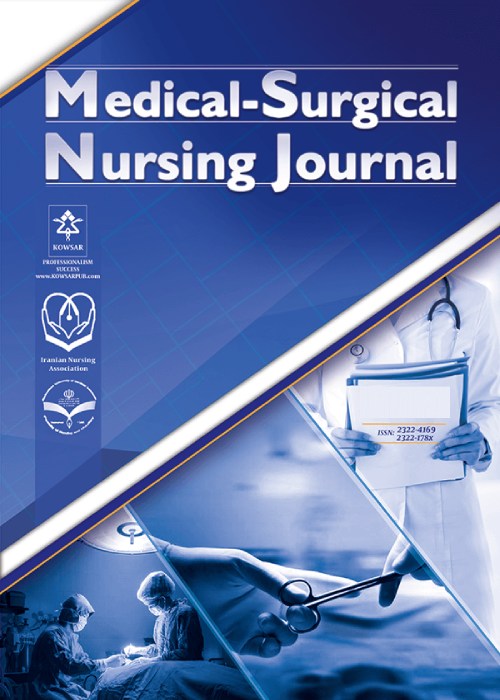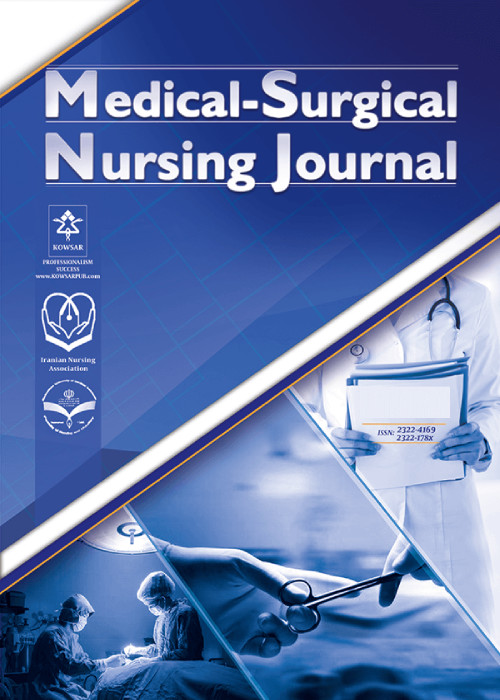فهرست مطالب

Iranian Journal Of Medical - Surgical Nursing
Volume:11 Issue: 1, Feb 2022
- تاریخ انتشار: 1401/04/20
- تعداد عناوین: 6
-
-
Page 1
Context:
The most common cause of bilateral lower extremity edema during pregnancy is venous insufficiency, that is a physiological process. Although it is not a serious complication, it can lead to substantial pain, heaviness, nocturnal cramps, tingling, and numbness. In this regard, foot massage is a prominent non-pharmacological practiceamonghealthcare providers. This studyaimed to evaluate non-pharmacological interventions utilized to alleviate the symptoms of lower extremity edema during pregnancy.
Evidence Acquisition:
This narrative review included all randomized controlled trials during 2011 - 2021 evaluating the symptoms of lower extremity edema during pregnancy. For literature review, databases including MEDLINE, PubMed, EMBASE, Cochrane, and SID were searched using the following keywords: “management,” “pregnancy,” “obstetric”, “oedema”, “edema”, “pharmacological treatment”, “lower-extremity edema”, “late pregnancy”, and “non-pharmacological treatment”.
ResultsIn terms of analyzed outcomes, there were substantial differences between the assessed trials. The trials had a high risk of performance and detection bias and were essentially unclear for selection bias. Finally, seven studies were included and analyzed. Compression stockings and external massage appeared to reduce lower extremity edema.
ConclusionsThere is not enough evidence for managing physiological lower extremity edema during pregnancy. Further trials with appropriate methodology and analysis of outcome are needed.
Keywords: Pregnancy, Lower-Extremity Edema, Treatment -
Page 2Background
Many families of dialysis patients consider the lack of knowledge about the disease and type of care as the main reason for the difficulty in providing effective care to patients.
ObjectivesThe present study aimed to assess the effectiveness of family-centered care education in the care knowledge of caregivers of hemodialysis patients.
MethodsThis quasi-experimental study was conducted on 80 main primary caregivers of hemodialysis patients in two teaching hospitals associated with Zahedan University of Medical Sciences, Zahedan, southeast Iran, in 2021. The family caregivers were randomly assigned to intervention and control groups (40 in each group) using permutation blocks. The experimental group received the family-based training program, and the control group received the usual care plan. The data were collected using the care knowledge questionnaire before and one month after the intervention. Then, the data were analyzed using the chi-square test, independent t-test, paired samples t-test, and analysis of variance (ANOVA) by SPSS software (version 22) with a significance level of less than 0.05.
ResultsThe mean scores of caregivers’ knowledge in the intervention group before and after the intervention were 10.42 ± 3.23 and 21.47 ± 3.21 (P = 0.001) and in the control group were 11.27 ± 3.90 and 12.45 ± 3.40 (P = 0.12). Furthermore, the results of the independent samples t-test showed that the care knowledge of the participants in the intervention group improved significantly after the intervention (P = 0.001), compared to that of the control group (P = 0.12). The results of ANOVA showed that themeanscores of care knowledge of caregivers in the two groups were significantly different after the intervention (P = 0.001)
ConclusionsProviding family-centered care education with the involvement of family caregivers can improve the care knowledge of the caregivers of hemodialysis patients. Given the significant role of caregivers in providing care services to these patients, special attention needs to be paid to the education of caregivers in educational programs.
Keywords: Education, Family-Centered Care, Knowledge, Caregivers, Hemodialysis -
Page 3Background
Due to the crisis of shortage of specialized nurses and high workload in intensive care units and emergency departments of hospitals during the COVID-19 pandemic, hospital managers had to use nurses and staff in other departments as reinforcements despite their lack of necessary competency to work in those departments. Hence, this study investigated surgical technologists’ work experiences during the COVID-19 disaster.
MethodsThis qualitative study was conducted using the conventional content analysis method at Alborz University of Medical Sciences. The participants were 42 surgical technologists selected using purposive sampling from 14 hospitals in 10 cities of Iran. Data were collected through semi-structured interviews and analyzed in MaxQDA2 software using the content analysis method.
ResultsThe results of this study were classified into two main categories, "challenges" and "coping strategies. The first main category consists of three subcategories, "psychological-emotional stress," "managerial crises," and "physical injuries." The second main category also includes three subcategories, "emotion-based strategy," "cognition-based strategy," and "problem-based strategy."
ConclusionsThe surgical technologists’ experience indicated that the COVID-19 crisis posed serious challenges, mostly related to the shortage of protective facilities and the lack of adequate training about self-care and patients in wards with no work experience. Therefore, managers of hospitals should offer appropriate purposive training courses to sufficiently develop their staff’s knowledge and competence to manage the crisis in pandemics or epidemics.
Keywords: COVID-19, Crisis, Surgical Technologist, Work Experience -
Page 4Background
Coronary artery disease (CAD) is a chronic disease. These patients need a high level of illness perception and self-care behaviors until the end of their lives.
ObjectivesThe present study aimed to examine the effect of the teach-back method on illness perception and self-efficacy in patients with CAD.
MethodsThis quasi-experimental study was conducted on 100 patients with CAD hospitalized in the coronary care units (CCUs) of Zahedan University of Medical Sciences in southeast Iran in 2021. The patients were selected through convenience sampling and divided into two intervention and control groups using simple randomization. The self-care training program was implemented individually for the patients in the intervention group in three sessions (30 - 45 minutes) on three consecutive days 24 hours after the patient’s admission to the hospital. The Brief Illness Perception Questionnaire (Brief IPQ) and Cardiovascular Management Selfefficacy Scale (CMSES) were completed by the patients in the two groups before and one month after the intervention. The collected data were analyzed in the statistical package for the social sciences (SPSS v.22) software using the independent samples t-test, paired samples t-test, chi-square test, Fisher’s exact test, regression test, and analysis of covariance (ANCOVA) at a significant level of P < 0.05.
ResultsIn pre-test, the two groups had no significant difference in the mean score of illness perception (P = 0.49). However, the mean score of self-efficacy was significantly higher in the intervention group (P = 0.01). In the post-test, the two groups had significant differences in both illness perception (P = 0.002) and self-efficacy (P = 0.001). The results of ANCOVA showed that by controlling the effect of the pre-test, the mean scores of illness perception (P < 0.001) and self-efficacy (P = 0.007) were significantly different between the two groups after one month of the intervention.
ConclusionsThe teach-back method improved illness perception and self-efficacy in patients with CAD. Thus, following the insights from this study and given the vital role of nurses in patient education, nurses and medical staff can use the teach-back method to improve illness perception and self-efficacy in these patients.
Keywords: Patient Education, Teach-Back Method, Illness Perception, Self-efficacy, Coronary Artery Disease -
Page 5Background
Pregnancy-induced hypertension, preeclampsia, and eclampsia syndrome are multisystem disorders associated with adaptive changes in the fetal circulation and cause a marked imbalance in the hemostatic system of the mother and fetus.
ObjectivesThis study aimed to compare hematological parameters in newborns of mothers with and without preeclampsia.
MethodsThis prospective case-control study included 30 newborns of mothers with preeclampsia and 30 newborns with normotensive mothers matched for age and sex as a control group. Umbilical cord blood samples were collected from all newborns, and complete blood count and ferritin levels were measured. The data were analyzed using SPSS version 21, and the difference between the two groups was compared using the independent t-test and Mann-Whitney test.
ResultsThe newborns of mothers with preeclampsia had higher mean corpuscular volume, mean corpuscular hemoglobin, red cell distribution width, mean platelet volume, and platelet distribution width but lower white blood cell counts, platelet counts, and ferritin level than those of the control group (P < 0.05). Also, the mean red blood cell count, hemoglobin, and hematocrit was higher in the preeclamptic mothers’ newborns compared to those of the control group, although not significant (P > 0.05).
ConclusionsNewborns of mothers with preeclampsia should be carefully evaluated and monitored regarding hematologic abnormalities and early diagnosis of possible complications.
Keywords: Newborn, Hematologic Parameters, Hypertension, Pregnancy, Preeclampsia


